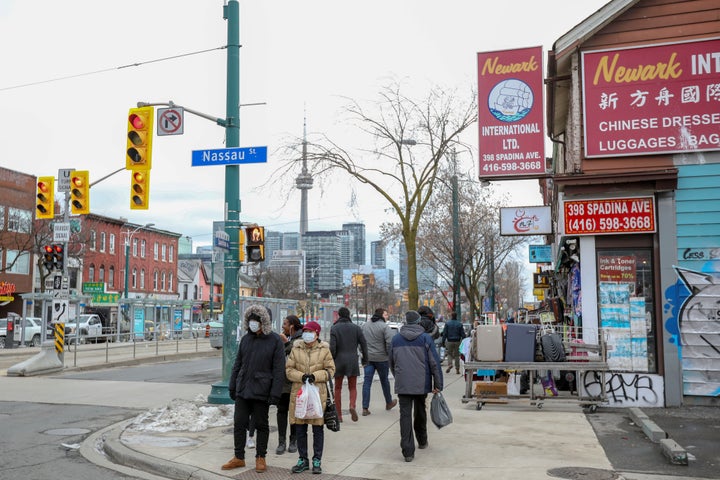
This is part of an ongoing HuffPost Canada series on food insecurity and how it’s affecting Canadians during the COVID-19 pandemic. In this edition, we delve into the marketing behind a viral supermarket ad, the criticism that followed, and ways budget-minded Canadians can shop ethically during the COVID-19 pandemic.
Ask any Canadian who’s bought groceries at No Frills and they can probably confirm that, unlike what’s shown in the supermarket’s latest viral ad, they’ve never flown through aisles, surfboarded on their receipts, or encountered a grandma shopping faster than Usain Bolt.
These superheroic feats can be seen in a short animated commercial by No Frills released late last year that’s taken off on Twitter as of late, due to an incredulous tweet that’s racked up more than 3.7-million views and nearly 300,000 likes.
Many praised its effectiveness as an ad, earning professional kudos from experts interviewed by the Toronto Star.
Twitter users compared its four leads to anime characters, referencing popular shows like “Naruto.” Others scratched their heads wondering why a discount supermarket chain poured so much effort and resources into the project: “No Frills going hard for absolutely no reason at all,” was a commonly shared opinion.
Canadian Twitter helpfully shared the realities of shopping at No Frills and the ad’s related comic strips, as well as examples of previous bombastic marketing campaigns by both No Frills and its closely related No Name brand.
But amid all the positive response, for some, the ad’s production values highlighted a different area of business where the expenses could have gone: improving worker conditions.
A meme starring Lisa Simpson from “The Simpsons” captured the differing views in a nutshell.
“It’s still the same Weston grocery empire that’s given millions to Conservatives, fixed the price of bread ... fought hard to lower minimum wages and eliminated pandemic pay,” Lisa says in the meme. Her words, however, go unheeded.
No Frills is owned by Loblaw Companies Ltd., run by the Weston family. They also own chains such as T&T, Shoppers Drug Mart, and Real Canadian Superstores. The Westons are the third-wealthiest family in Canada and the biggest player in the national grocery sector, with Forbes reporting patriarch Galen Weston’s family fortune is around $8.6-billion USD, or $10.8-billion CAD.
Loblaw Companies and its supermarkets have seen their sales grow over the last year, but have yet to reverse last summer’s decision to stop paying workers more during the COVID-19 pandemic. Last November, a Loblaw spokesperson told CBC there were no plans to reinstate this wage bump from the company.
The Financial Post reported last July that Loblaw Companies blamed pandemic pay for partially lowering their Q2 earnings.
Toronto-based activist and writer David Bush, who previously criticized Weston for profiting from cutting pandemic pay in a feature story for Spring Magazine, told HuffPost Canada the ad was smart marketing, but has a glaring omission.
“What it doesn’t tell you about is the rampant inequality in the Loblaws empire,” Bush said in a text statement, adding that “in order to boost their profits, the Loblaws empire is trying to leverage the heroic image of their workers without actually paying them or treating them like heroes.”
“The Loblaws empire is trying to leverage the heroic image of their workers without actually paying them or treating them like heroes.”
- David Bush
Turning customers and employees into heroes falls in line with the original marketing behind the ad, which is part of No Frills’ gravity-defying “Haulers” campaign, created by the ad agency John St. in 2018.
“We knew we needed a campaign that was both aspirational and unifying, but also stayed true to the brand,” said No Frills marketing director Ashley McGill to marketing magazine The Message on the animated ad. “We needed to celebrate our ‘Haulers’ And what’s more aspirational than tapping into the bravado of comic superheroes?”
The inspiration (and money) sunk into the ad
Killian Ng, a Mississauga, Ont.-based environmental artist who works in animation, told HuffPost Canada that although there are many anime comparisons from Twitter, the ad’s style is more similar to Western comic books, with nods to popular Marvel superheroes in particular. Indeed, the ad’s very title, “Enter The Haulerverse,” references the popular 2018 film “Spider-Man: Into the Spider-Verse.”
“It comes off as anime because in the Western world, we’ve gone more towards 3D and 2D rigged animation,” they explained, the latter referencing a computer animation technique. “A lot more 2D, frame-by-frame drawn animation is coming out of Japan, so there’s more to connect to. That said, there has been a response within anime to the superhero format.”
Ng singled out superhero-genre anime like “One Punch Man” and “My Hero Academia,” two of the most popular shows made in recent years, as examples. Fight scenes in these shows feature similar larger-than-life moves as those done by the characters in the ad.
Marvel superheroes and anime have become more mainstream in recent years, thanks to streaming services; 2020 was a year of massive international growth for the anime industry and Netflix in particular.
To capitalize on the Marvel-loving trend, No Frills and its marketing agency outsourced the animation process to France; “Enter The Haulerverse” was made by Brunch Studio in Paris, known for animating Ariana Grande’s 2020 perfume commercial.
It’s unknown how much No Frills paid for their ad, as factors like syndication expenses, agency discounts, and deadlines are variable. A request for comment on this amount from No Frills’ communications firm was not answered at the time of publication.
Many estimates for a highly-stylized animated minute-long commercial from a company sized similarly to Brunch Studio range anywhere from four to five-figures. An animation cost calculator by designer Emil Villumsen ballparked costs to be as low as $22,000 or as high as $123,000.
For comparison, Loblaw supermarket workers’ “hero pay” was an extra toonie per hour before it was nixed.
Animated ads like these entice younger shoppers
Making a video that’s popular among anime fans and comic lovers may be a calculated move by No Frills to use their Haulers campaign ― hailed as a “millenial dream” and picking up awards for raising No Frills’ bottom line ― to attract Gen Z, who value a video’s visuals above all, Forbes states.
“Gen Z tends to place a higher value on entertainment. They consume cultural content for fun or to relieve boredom. As such, they are particularly interested in topics like internet culture/memes, humour, and gaming,” an Ontario Creates study on Gen Z also noted.
These younger consumers, however, may stand to lose the most when it comes to corporate social responsibility falling flat, as critics would say. Large numbers of front-line food and retail workers are young Canadians, making these generations most vulnerable to pandemic-related economic downturn, through pay cuts and job losses.
Tips for being a mindful shopper during COVID-19
Canadians who’ve learned about the ethical context related to the No Frills’ animated ad may be examining their own shopping habits more closely.
HuffPost Canada spoke to Ontario-based dietitian Trista Chan for tips on how to buy food without breaking the bank or going against your morals.
Take stock of your local indie grocers: Chan recommends Canadians assess their budget and what prices are like at their independent neighbourhood grocers.
“See if there’s any way to support family-owned grocery stores down the street, or places like Chinatown, which is suffering immensely during the pandemic,” she said. “The money goes directly to the people who are living in your neighbourhood, there are no large corporations. The more direct-from-consumer, the better.”

This may also be a safer route, as big-box stores in provinces like Ontario have been slapped with numerous COVID-19 violations as of late. Not shopping at peak hours at three local corner stores may minimize spread more than shopping at a busy big retailer, she noted.
Get food boxes delivered when possible: Food boxes for Canadians dealing with food insecurity, like Montreal’s Good Food Box and the Emergency Food Box in Ontario, often partner with local farmers. Boxes can be beneficial for those looking to reduce food waste.
“They’re ensuring that you’re getting only what you need and not really hoarding,” Chan said.
Community fridge projects, like those in Calgary and Toronto, also earned Chan’s seal of approval.
Shop at supermarkets that reflect your values: If “hero pay” is a major issue for you, it may be worth only shopping at supermarkets that pay employees this added wage. For example, pandemic pay was reinstated at Sobeys after outcry.
If you need to shop somewhere you don’t want to, take heart: For Canadians who live in areas where shopping at a big-box supermarket is their only option, Chan suggests reading labels to make sure that, at the very least, you’re prioritizing products that are locally-made or Canada-grown produce.
Advocate for others: Shopping local may come at higher prices that some may not be able to afford. In these cases, Chan suggested taking a harm reduction approach.
“Unfortunately, buying from places that keep people in poverty can fuel [unethical worker conditions], but try to be mindful,” she said. “If you have the ability to support a food advocacy organization like FoodShare Toronto, you’re doing your part to help change the narrative.”
Also on HuffPost: